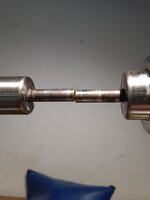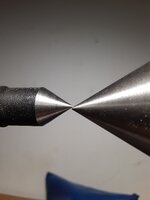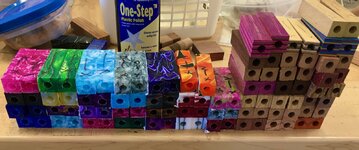Hey Everyone,
I'm a newbie to pen turning, and I am having some issues with drilling a slimline and sierra blank. I have read some people's discussions with the similar problem I am having, and I tried implementing various people's suggestions, but I am still having some issues. I'm using a new Lugana 1216 lathe with a NOVA 48232 G3 Reversible Wood Turning Chuck, NOVA 6034 Pen Plus Jaws, and Heavy Duty 1/2' Keyed Drill chuck (from Amazon/Woodriver). In an attempt to make some slimline pens out of acrylic, I proceeded to use a 7mm brad point bit that I purchased from either woodcraft or penn state. After completing the drilling at 550rpm's, the pen tube would simply fall completely through the hole. I have a feeling it's not supposed to do that. I tried using a 17/64 standard drill bit running the lathe at 550 rpm's, and the problem seemed to correct itself; however, the entrance hole is slightly larger than the exit hole. When I flip the blank around thus allowing the drill bit to enter the exit hole, I can get it to enlarge thus matching the other end's diameter. The tube doesn't fall out, but it is somewhat snugged and with very little effort to get out. I have made about seven slimline pens, but I have a feeling this method is not the best/standard.
With the sierra, I tried using the 27/64 brad point and the hole is way to large for the tube. Since I don't have a stub bit, I used the 17/64" as a starter hole, and it did not help. I took the same approach as the slimline and used a 13/32 standard drill bit running at 550rpm. Again, having the same outcome as the slimline. I made two sierra pens.
I have double checked the pen jaws, the blank in the jaws, the drill bit, and everything is locked with no movement. I have tried the pencil in the drill chuck, hand turning the blank and it makes a point. I made sure the drill bit was far enough in the chuck, I entered the blank very slowly and drill only about 1/2" to 3/4" at a time. I retract the quill and pull the tailstock back with the lathe off and then I reinsert the drill bit to the depth of the already drilled hole, turn the lathe on and extend the quill another 1/2 to 3/4". All of the drill bits I am using are new. I am open to any and all suggestions.
I'm a newbie to pen turning, and I am having some issues with drilling a slimline and sierra blank. I have read some people's discussions with the similar problem I am having, and I tried implementing various people's suggestions, but I am still having some issues. I'm using a new Lugana 1216 lathe with a NOVA 48232 G3 Reversible Wood Turning Chuck, NOVA 6034 Pen Plus Jaws, and Heavy Duty 1/2' Keyed Drill chuck (from Amazon/Woodriver). In an attempt to make some slimline pens out of acrylic, I proceeded to use a 7mm brad point bit that I purchased from either woodcraft or penn state. After completing the drilling at 550rpm's, the pen tube would simply fall completely through the hole. I have a feeling it's not supposed to do that. I tried using a 17/64 standard drill bit running the lathe at 550 rpm's, and the problem seemed to correct itself; however, the entrance hole is slightly larger than the exit hole. When I flip the blank around thus allowing the drill bit to enter the exit hole, I can get it to enlarge thus matching the other end's diameter. The tube doesn't fall out, but it is somewhat snugged and with very little effort to get out. I have made about seven slimline pens, but I have a feeling this method is not the best/standard.
With the sierra, I tried using the 27/64 brad point and the hole is way to large for the tube. Since I don't have a stub bit, I used the 17/64" as a starter hole, and it did not help. I took the same approach as the slimline and used a 13/32 standard drill bit running at 550rpm. Again, having the same outcome as the slimline. I made two sierra pens.
I have double checked the pen jaws, the blank in the jaws, the drill bit, and everything is locked with no movement. I have tried the pencil in the drill chuck, hand turning the blank and it makes a point. I made sure the drill bit was far enough in the chuck, I entered the blank very slowly and drill only about 1/2" to 3/4" at a time. I retract the quill and pull the tailstock back with the lathe off and then I reinsert the drill bit to the depth of the already drilled hole, turn the lathe on and extend the quill another 1/2 to 3/4". All of the drill bits I am using are new. I am open to any and all suggestions.



